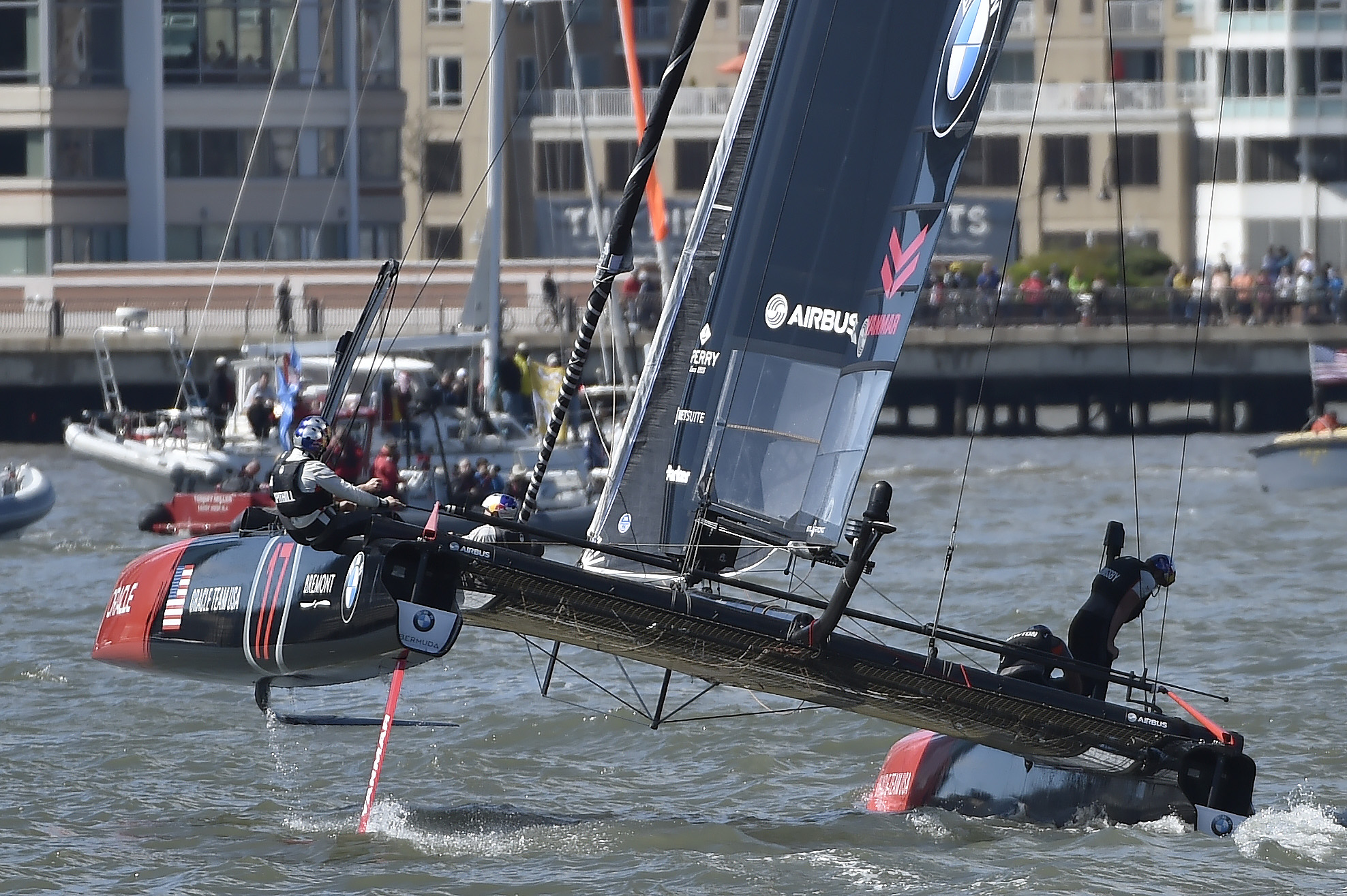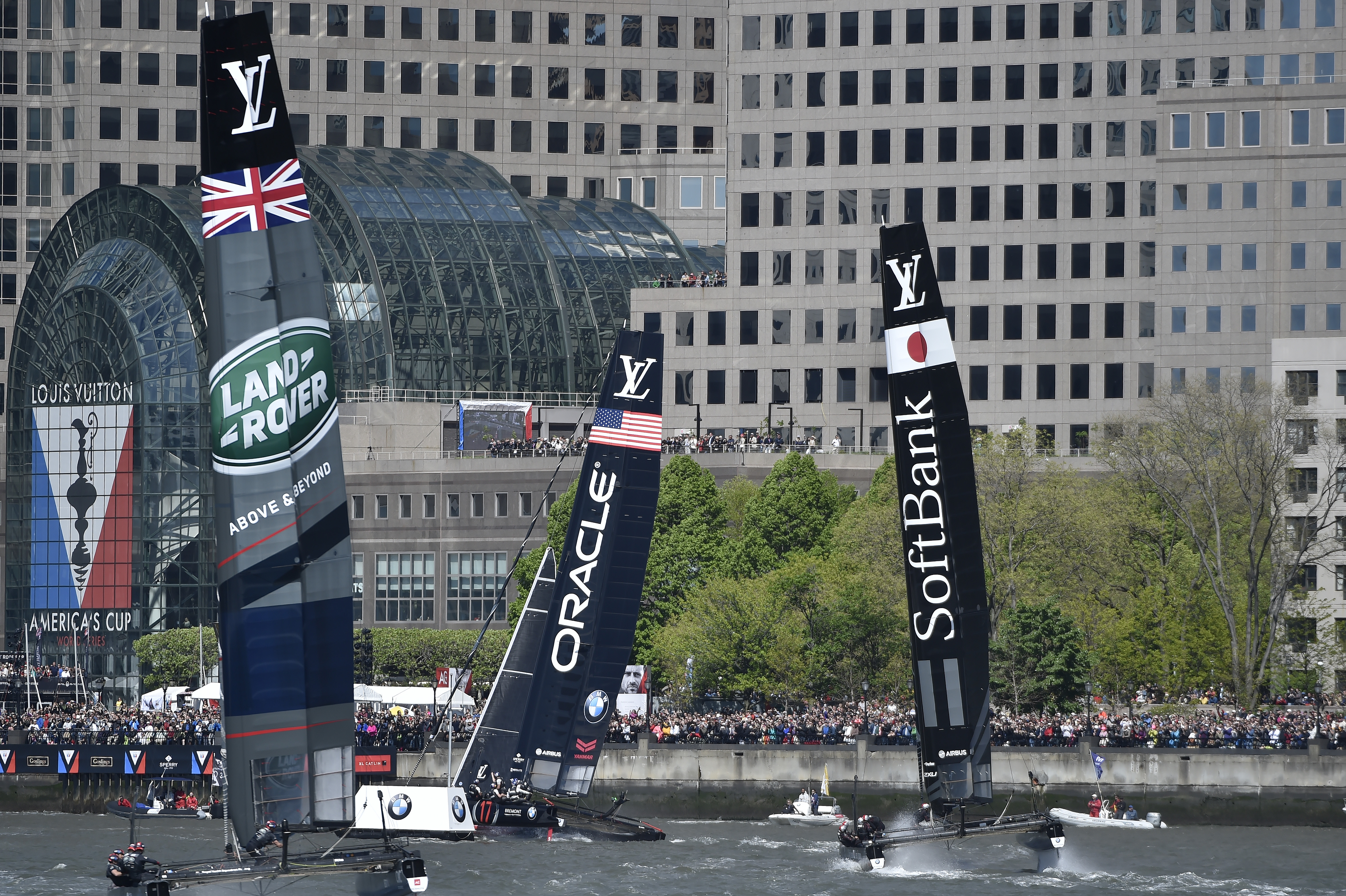America's Cup wings fly in New York
The sleek craft with their twin hulls and distinctive vertical wings were a far cry from the 12-metre sloops of repeat winner Dennis Conner’s Stars & Stripes, which dominated the sport on and off between 1987 and 2003.
Brookes Moody, whose father is a Bonanza pilot operating out of Somerset, New Jersey, helped provide commentary during the races and explained the similarities between the racing ships and aircraft. “Bernoulli’s Principle applies to both pilots and sailors,” said Moody. “Pilots know that the air moving over the outside of a wing or sail moves faster than the air moving on the inside to create lift. The same thing is happening in the keel below the boat where the hydrodynamics in the water are mimicking the aerodynamics of the sail in the wind.”
The preliminary competition was part of a series of events leading up to 2017’s America’s Cup in Bermuda, a racing event known as the oldest trophy in international sport.
 Oracle Team USA skipper Jimmy Spithill pushed his sails and crew to their limits to coax the twin-hulled craft to “fly” above the water on its foil daggerboards and rudders. Three- to five- knot river currents tugged at the ship from below while it approached 30 mph on the fast reaches between colorful red-and-blue buoys defining the course. “I don’t think there are many boats that can race in that,” said Spithill, “but in these boats you can.”
Oracle Team USA skipper Jimmy Spithill pushed his sails and crew to their limits to coax the twin-hulled craft to “fly” above the water on its foil daggerboards and rudders. Three- to five- knot river currents tugged at the ship from below while it approached 30 mph on the fast reaches between colorful red-and-blue buoys defining the course. “I don’t think there are many boats that can race in that,” said Spithill, “but in these boats you can.”
Spithill’s Team USA won the America’s Cup in 2010, defended the title in 2013, and he said the Hudson preliminaries helped him fine-tune his crew.
Aircraft technology including wind-tunnel testing, advanced aerodynamics, and lighter-weight materials has steadily crept into the sport over the past 25 years.
America’s Cup regulars point to the secret and then-radical keel on 1983 winner Australia II as a major technological turning point. The device was famously kept shrouded from competitors whenever the ship was lifted to and from the water. During a deciding seventh race, the ship’s short chord with its winged keel and increased nimbleness led to a victory that wrestled the trophy from America’s New York Yacht Club for the first time in 132 years.
Following on that advance, in 2004 car-maker BMW dispatched two aviation and aerospace engineers to Oracle’s entry to identify the ideal speed-to-weight sweet spot without compromising the integrity of the ship’s hull. The engineers’ goals were to make the keel as heavy as possible to keep the yacht right-side-up while constructing the hull as light as possible without it buckling under pressure.
Six years ago yacht racing technology again changed dramatically when the Oracle team replaced its 60-meter mast and 620-square-meter cloth mainsail with a “hard, fixed wing that is 80 percent larger than a Boeing 747 wing” the Scientific American wrote at that time. The magazine said the device made the yacht “difficult and dangerous to maneuver.” On the other hand, the aircraft wing-inspired rigid main sail was able to harness even the slightest puff of wind and efficiently transfer it into sailing momentum across the water.
 The resulting marriage of the aircraft wing mainsail with today’s aerodynamic multi-hull designs and their shapely foils allow the new ships to be fast and efficient. Their modern design can withstand tremendous amounts of force, according to the BMW engineers.
The resulting marriage of the aircraft wing mainsail with today’s aerodynamic multi-hull designs and their shapely foils allow the new ships to be fast and efficient. Their modern design can withstand tremendous amounts of force, according to the BMW engineers.
In New York, Artemis Racing helmsman Nathan Outteridge said the combination of the boats, their technology, and the venue made for “a very tricky day” of racing. “These boats are high performance and really dangerous to sail. You have to take safety as your first option.”
His team was penalized several times during three races May 9, which saw the ebb and flow of wind and water conditions under a blue sky and shimmering skyscrapers nearby. “We were reaching in about five knots, and we got this puff of about 25 knots of breeze,” said Outteridge. “If you just keep aiming at the mark you get capsized” so the crew had to quickly “jibe around, tack around and go back out. Meanwhile New Zealand missed the puff, drifted behind us and won the race.”
Spithill said Oracle Team USA was running neck-and-neck with Emirates Team New Zealand around that last mark: “It was a fun race, it was never over until the finish, with a lot of passing and for sports fans I don’t think it gets a whole lot better than that.” Oracle’s second-place finish in New York assured them of valuable points it can use in competition leading up to the America’s Cup championship. “Team New Zealand sort of threw a Hail Mary at the end,” said Spithill, “and all you can do is take your hat off and congratulate them.” Indeed, New Zealand skipper Glenn Ashby said the race “was absolutely insane.”
“Chicago will be awesome” when the tour stops there in June, said Spithill. Additional Louis Vuitton America’s Cup preliminary events are scheduled for Portsmouth, England, in July; Toulon, France, in September; and a to-be-determined stop in Asia before the final battle in Bermuda.
America's Cup Media Gallery Component



